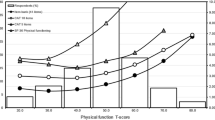Studies provide convincing arguments to support the development of functional capacity instruments based on the Dictionary of Occupational Titles (DOT). The purpose of this study is to investigate the item-level measurement qualities of a newly developed DOT-based functional capacity instrument for clients undergoing rehabilitation treatment for back pain. Client and therapist ratings were collected on 124 clients from 27 rehabilitation sites using the newly developed Occupational Rehabilitation Data Base (ORDB) functional capacity instrument. Rasch analysis was used to investigate: (1) unidimensionality, (2) hierarchical item difficulty continuum, (3) rater severity, and 4) person–item match. Overall, the functional capacity scale of the ORDB showed good measurement qualities. All items, except the Handling item fit the Rasch measurement model. Because of high fit statistics and loading on factors independent from the remainder of the items, the “handling” item was removed, from further analyses. Separate client-rated and therapist-rated instruments retained good item-level psychometrics. While client and therapist items showed similar item-difficulty hierarchical structures, clients had a tendency to be more severe in their rating and the correlation between client and therapist ratings was relatively low, 0.32. These findings suggest that Handling items should not be included as a DOT measure for clients with back pain. While the above psychometric study supports using client or therapist ratings as independent instruments, the lack of concordance between these ratings requires further investigation.

Similar content being viewed by others
Notes
In order to compare item difficulties across the client and therapist rated analyses, each analysis was anchored at the average person ability measure of 0.
REFERENCES
Abdel-Moty E, Fishbain DA, Khalil TM, Sadek S, Cutler R, Steel-Rosomoff R, Rosomoff HL. Functional capacity and residual functional capacity and their utility in measuring work capacity. Clin J Pain 1993; 9: 168–173.
Gross DP. Measurement properties of performance-based assessment of functional capacity. J Occup Rehabil 2004; 14(3): 165–174.
King PM, Tuckwell N, Barett TE. A critical review of functional capacity evaluations. Phys Ther 1998; 8: 852–866.
Velozo CA. Work evaluations: Critique of the state of art of functional assessment of work. Am J Occup Ther 1993; 47: 203–209.
Mayer TG. Chapter 7: Assessment of lumbar function. In Disability Symposium. Clin Orthop Rel Res 1987; 221: 99–109.
Cutler RB, Fishbain DA, Steele-Rosomoff R, Rosomoff HL. Relationships between functional capacity measures and baseline psychological measures in chronic pain patients. Spine 2003; 1(4): 249–258.
Matheson LN, Isernhagen SJ, Hart DL. Relationships among lifting ability, grip force, and return to work. Phys Ther 2002; 82(3): 249–256.
Mooney V. Functional capacity testing: its role in assessing and treating back pain. Pain Manage 1990; 3(2): 107–113.
Abdel-Moty E, Khalil T, Sadek S, Dilsen E, Fishbain DA, Steel-Rosomoff R, Rosomoff HL. Functional capacity assessment: A test battery and its use in rehabilitation. In: Mital A, ed. Advances in industrial ergonomics & safety I. New York: Taylor & Francis, 1992, pp. 1171–1177.
Fishbain DA, Abdel-Moty E, Cutler R, Khalil TM, Sadek S, Steel-Rosomoff R, Rosomoff HL. Measuring residual functional capacity in chronic low back pain patients based on the dictionary of occupational title. Spine 1994; 19(8): 872–880.
Hadler NM. Disabling backache in France, Switzerland and the Netherlands: Contrasting sociopolitical constraints on clinical judgment. J Occup Med 1989; 31: 823–831.
Fishbain DA, Cutler RB, Rosomoff HL, Khalil T, Abdel-Moty E, Steele-Rosomoff R. Validity of the dictionary of occupational titles residual functional capacity battery. Clin J Pain 1999; 15: 102–110.
Manual for Valpor Component Work Sample 1, 9, 11. Tuscon, Arizona: L Valpar International Corporation, 1980.
Kopec JA. Measuring functional outcomes in persons with back pain. Spine 2000; 25: 3110–3114.
Dobel SE, Fisk JD, Fisher AG, Ritvo PG, Murray TJ. Functional competence of community-dwelling persons with multiple sclerosis using the assessment of motor and process skills. Arch Phys Med Rehabil 1994; 75: 843–851.
Haley SM, Andres PL, Coster WJ, Kosinski M, Ni P, Jette AM. Short-form activity measure for post-acute care. Arch Phys Med Rehabil 2004; 85(4): 649–660.
Haley SM, McHorney CA, Ware JE, Jr. Evaluation of the MOS SF-36 physical functioning scale (PF-10): I. Unidimensionality and reproducibility of the Rasch item scale. J Clin Epidemiol 1994; 47: 671– 684.
Haley SM, McHorney CA, Ware JE, Jr. Evaluation of the MOS SF-36 Physical Functioning Scale (PF-10): II. Comparison of relative precision using Likert and Rasch scoring methods. J Clin Epidemiol 1997; 50(4): 451–461.
Heinemann AW, Linacre JM, Wright BD, Hamilton BB, Granger C. Relationships between impairment and physical disability as measured by the functional independence measure. Arch Phys Med Rehabil 1993; 74: 566–573.
White L, Velozo CA. The use of Rasch measurement to improve the Oswestry classification scheme. Arch Phys Med Rehabil 2002; 83: 822–831.
Silverstein B, Fisher WP, Kilgore KM, Harley JP, Harvey RF. Applying psychometric criteria to functional assessment in medical rehabilitation: II. Defining interval measures. Arch Phys Med Rehabil 1991; 73: 507–518.
Silverstein B, Kilgore KM, Fisher WP, Harley JP, Harvey RF. Applying psychometric criteria to functional assessment in medical rehabilitation: I. Exploring unidimensionality. Arch Phys Med Rehabil 1991; 72(9): 631–637.
Whiteneck GG, Charlifue SW, Gerhart KA, Overholser JD, Richardson GN. Quantifying handicap: A new measure of long-term rehabilitation outcomes. Arch Phys Med Rehabil 1992; 73: 519–526.
Hays RD, Morales LS, Reise SP. Item Response Theory and health outcomes measurement in the 21st century. Med Care 2000; 38(9, Suppl II): II-28–II-42.
Velozo CA, Peterson E. Using Rasch analysis to develop meaningful fear of falling measures for community dwelling elderly. Am J Phys Med Rehabil 2001; 80(9): 662–673.
McHorney CA. Generic health measurement: Past accomplishments and a measurement paradigm for the 21st century. Ann Intern Med 1997; 127: 743–750.
McHorney CA, Haley SM, Ware JE, Jr. Evaluation of the MOS SF-36 Physical functioning scale (PF-10): II. Comparison of relative precision using Likert and Rasch scoring methods. J Clin Epidemiol 1997:50(4): 451–461.
McHorney CA. Health status assessment methods for adults: Past accomplishments and future challenges. Annu Rev Public Health 1999; 20: 309–335.
Weiss DJ. Adaptive testing by computer. J Consult Clin Psychol 1985; 3: 774–789.
Velozo CA Magalhaes L, Pan A, Leiter P. Differences in functional scale discrimination at admission and discharge: Rasch analysis of the Level of Rehabilitation Scale-III (LORS-III). Arch Phys Med Rehabil 1995; 76(8): 705–712.
McHorney CA, Haley SM, Ware JE, Jr. Evaluation of the MOS SF-36 Physical functioning scale (PF-10): I. Unidimensionality and reproducibility of the Rasch item scale. J Clin Epidemiol 1994; 47(6): 671–684.
Thurstone LL. Measurement of social attitudes. J Abnorm Soc Psycholol 1931; 26: 249–269.
Wright BD, Linacre JM. Observations are always ordinal; measurements, however, must be interval. Arch Phys Med Rehabil 1989; 70: 857–860.
Merbitz C, Morris J, Grip JC. Ordinal scales and foundations of misinference. Arch Phys Med Rehabil 1989; 70: 308–332.
Engelhard G. Monitoring raters in performance assessments. In: Tindal G, Haladyna T, eds. Large-scale assessment programs for ALL students: Development, implementation, and analysis. Mahwah, NJ: Erlbaum, 2002, pp. 261–287.
Fisher WP. Measurement-related problems in functional assessment. Am J Occup Ther 1993; 47(4): 331–337.
Kielhofner G, Mallinson T, Forsyth K, Lai J. Psychometric properties of the second version of the occupational performance history interview (OPHI-II). Am J Occup Ther 2001; 55(3): 260–267.
Tresi JA, Kleinman M, Ocepek-Welikson K. Modern psychometric methods for detection of differential item functioning: Application to cognitive assessment measures. Stat Med 2000; 19: 1651–1683.
Lunz ME, Stahl JA. The effect of rater severity on person ability measure: A Rasch model analysis. Am J Occup Ther 1993; 47(4): 311–317.
Wilson M, Wang W. Complex composites: Issues that arise in combining different modes of assessment. In Special Issues: Polytomous item response theory. Appl Psychol Measure 1995; 19: 51–71.
Velozo CA, Santopoalo R. Training manual: Occupational rehabilitation data base manual. Chicago: University of Illinois at Chicago, 1994.
U.S. Department of Labor, Employment and Training Administration. Selected characteristics of occupationals defined in the Dictionary of Occupational Titles. Washington, DC: U.S. Government Printing Office, 1981.
U.S. Department of Labor, Employment and Training Administration. Dictionary of Occupational Titles, 4th edn., Supplement. Washington, DC: U.S. Government Printing Office, 1986.
Linacre JM. WINSTEPS Rasch measurement computer program. Chicago: Winsteps.com, 2005.
Wright BD, Masters GN. Rating scale analysis. Chicago: MESA Press, 1982.
Wang WC, Chen CT. Item parameter recovery, standard error estimates, and fit statistics of the WINSTEPS Program for the family of Rasch models. Educ Psychol Measure 2005; 65: 376–404.
Avery LM, Russell DL, Raina PS, Walter SD, Rosenbaum PL. Rasch analysis of the Gross Motor Function Measure: Validating the assumptions of the Rasch model to create an interval-level measure. Arch Phys Med Rehabil 2003; 84: 697–705.
Velozo CA, Peterson EW. Developing meaningful fear of falling measures for community dwelling elderly. Am J Phys Med Rehabil 2001; 80: 662–673.
Davidson M, Keating JL, Eyres S. A low back pain version of the SF-36 physical functioning Scale. Spine 2004; 29(5): 586–594.
Linacre JM. Detecting multidimensionality: Which residual data-type works best? J Outcome Meas 1998; 2: 266–283.
Smith EV. Detecting and evaluating the impact of multidimensionality using item fit statistics and principle component analysis of residuals. J Appl Meas 2002; 3: 205–231.
Preacher KJ, MacCallum RC. Reparing Tom Swift's electric factor analysis machine. Understand Stat 2003; 2(1): 13–32.
White LJ, Velozo CA. The use of Rasch measurement to improve the Oswestry classification scheme. Arch Phys Med Rehabil 2002; 83: 822–831.
Mallinson T, Stelmack J, Velozo C. A comparison of the separation ratio and coefficient α in the creation of minimum item sets. Med Care 2004; 42(1, Suppl): I-17–I-24.
Norman GR, Steiner DL. Biostatistics: The bare essentials. St. Louise: Mosby Yearbook Inc., 1994.
Magaziner J, Zimmerman SI, Gruber-Baldini AL, Hebel JR, Fox KM. Proxy reporting in five areas of functional status. Comparison with self-reports and observations of performance. Am J Epidemiol 1997; 146(5): 418–428.
Grootendorst PV, Feeny DH, Furlong W. Does it matter whom and how you ask? Inter- and intra-rater agreement in the Ontario Health Survey. J Clin Epidemiol 1997; 50(2): 127–135.
Author information
Authors and Affiliations
Corresponding author
Rights and permissions
About this article
Cite this article
Velozo, C.A., Choi, B., Zylstra, S.E. et al. Measurement Qualities of a Self-Report and Therapist-Scored Functional Capacity Instrument Based on the Dictionary of Occupational Titles. J Occup Rehabil 16, 106–119 (2006). https://doi.org/10.1007/s10926-005-9014-z
Published:
Issue Date:
DOI: https://doi.org/10.1007/s10926-005-9014-z




